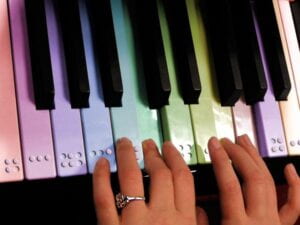Braille Pianette
Project Trajectory: Seeking to provide an even more sophisticated and creative way of articulating music to the general public, we’re carefully crafting/replicating a customized ‘piano keyboard’ that can produce tunes by itself. Combining this with the additional aspect of Processing, users will be able to use and see a visual piano particle that floats, correlated with the note they press. A further crucial component of Braille will be engraved onto the piano notes, allowing for individuals with blindness disabilities to nonetheless play their beloved tunes.
Project Proposal Plan: Like in the midterm creation, I will once again gladly cooperate with my partner Calvin Lin to design this piece together. Thinking of various project ideas, we wanted to include all aspects of what we learned, the intended audience, & the overall impact. Settling on this pianette (minipiano), we hoped to completely innovate our midterm piece. Not only would this project actively involve both Arduino & Processing programs, but simultaneously be meaningful in itself. Below, I will document the steps/layout that we plan to do.
– First, me and my partner would make the physical music keyboard. To simplify this design from a standard actual-sized piano, we decided to cut it down to two octaves (C, D, E, F, G, A, B notes twice). This will still allow tunes to be played, while efficiently maintaining its portability and difficulty. Now knowing basic knowledge of how to laser cut, we plan to finish a complete design of the piece through cuttle.xyz.
To not exclude any blind users, we will carefully research the disability and create an easily accessible Braille system located on the piano for them. For example, we would engrave each Braille letter onto the corresponding piano key (2 Octaves -14 keys total). In the end, we hope to customize the keyboard itself to make it aesthetically pleasing. A forest themed-piano is what we envisioned, with cute accessories to accompany the creation (leaves, flowers, green-colored items).
Here, the Arduino would connect the physical piece itself. It would serve the communication to the piano keys, telling the computer the selected key pressed. Soon, I will explain its other purposes.
-Second, the computer & Processing software will be used to generate the remaining aesthetic effects. Through Processing, we plan to program a fullscreen() that can show selected piano keys pressed with colorful tiles. Our inspiration was a popular game called Piano Tiles, in which users press falling keys for different notes. Instead of the tiles falling down, we intend to allow the tiles to float up, similar to the beautiful piano particle Youtube videos. Here, I will link an example. The screen color would be either black or white, with the tile color being either a random() function or a set color. Though, this would be customizable, so users can command and change the device to any color they desire.
After the midterm, we decided to change the external sound source to the actual computers. Past speakers were too complicated and failed to work, often leaving an unpleasant sound and experience. To improve this factor, we hope to directly code/upload a music library into our computers, & have the computer speaker generate the sound. By finishing this part, we would have all parts of the design put together. All physical, programming, & aesthetic aspects at this point would be completed. In the presentation, we might add more factors (dimmed lights, prepared music pieces, etc.) to increase user experience.

Context and Significance- As stated above, our project is inspired by real-life musicians and their dreams of inspiring an audience. Our project is intended for everyone, of course, but mostly includes blind individuals who wish to play piano. Blind individuals often feel discouraged when encountering standard pianos, as they generally have difficulty remembering the note location. Upon successful completion of this device, this would not occur anymore. With enough practice and timing, blind users can play their desired tones! Subsequent projects may continue to expand by adding more keys and more braille.
This project aligns with my definition of interaction as it allows a user to communicate using Arduino, then Processing listening & responding by sending out a piano particle. Additionally, the piano speaker would respond as it plays the corresponding sound. We wish to incorporate everything we’ve learned this semester into this project, including LED lights & other kit items. While it sounds complex, we’re enthusiastic about designing this piano & look forward to its invention.

Leave a Reply